Debden is a small rural village in the Uttlesford district of Essex in the East of England. It is located 4 miles (6 km) from Saffron Walden and 17 miles (27 km) from Cambridge.

Saffron Walden is a market town in the Uttlesford district of Essex, England, 12 miles (19 km) north of Bishop's Stortford, 15 miles (24 km) south of Cambridge and 43 miles (69 km) north of London. It retains a rural appearance and some buildings of the medieval period. The population was 15,504 at the 2011 census and 16,613 in the 2021 census.
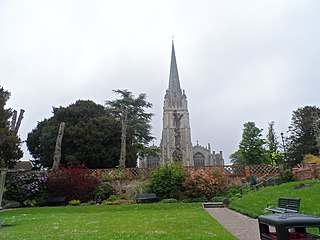
Uttlesford is a local government district in Essex, England. Its council is based in the town of Saffron Walden. The district also includes the town of Great Dunmow and numerous villages, including Stansted Mountfitchet, Takeley, Elsenham, Thaxted, and Newport. The district covers a largely rural area in the north-west of Essex. London Stansted Airport lies within the district.

Clavering is a village and also a parish in north-west Essex in England. It is about 20 miles (32 km) from Cambridge and 50 miles (80 km) from Southend-on-Sea. The name 'Clavering' means 'place where clover grows'.

Chrishall is a small village and civil parish in the Uttlesford district of Essex, England. The village lies close to the borders with Cambridgeshire and Hertfordshire, 12 miles (20 km) south of Cambridge and equidistant [6 miles (10 km)] between the two medieval market towns of Saffron Walden and Royston.

Arkesden is a village and civil parish in the Uttlesford district of Essex, England.

Ashdon, is a village and civil parish in Essex, England. It is about 4 miles (6 km) northeast of Saffron Walden and 23 miles (37 km) northwest from the county town of Chelmsford. The village is in the district of Uttlesford and the parliamentary constituency of Saffron Walden. The village has its own Parish Council.
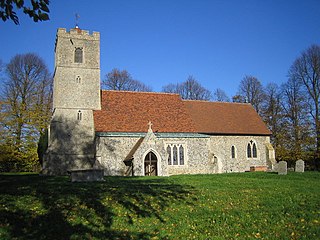
Quendon and Rickling is a civil parish in the Uttlesford district of Essex, England with an area of 2,048 acres. The population of the civil parish at the 2011 was 587. It is a linear settlement on the B1383 between Saffron Walden and Bishops Stortford. Quendon & Rickling stand 300 feet above sea level on a watershed between two rivers: the Cam to the east, flowing north through Cambridge to the Ouse flowing on to the Wash.

Barnston is a village and civil parish in Essex, England. The village is on the B1008 road, about 1+3⁄4 miles (2.8 km) south-east of Great Dunmow and 9 miles (14 km) north-north-west from the county town of Chelmsford.

For the historic house in Essex called Langley's, see Great Waltham.

Earls Colne is a village in Essex, England named after the River Colne, on which it stands, and the Earls of Oxford who held the manor of Earls Colne from before 1086 to 1703.

Elsenham is a village and civil parish in north-west Essex in eastern England. Its neighbouring settlements include Bishop's Stortford, Saffron Walden and Stansted Mountfitchet.
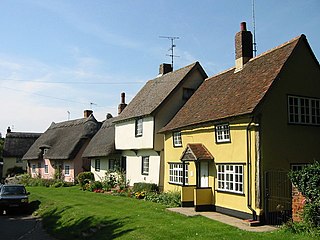
Wendens Ambo is a village in the Uttlesford district of Essex, England. The population at the 2011 census was measured at 473. Its name originates from the merging of two originally separate villages called Wenden Magna and Wenden Parva, ambo being the Latin for "both".
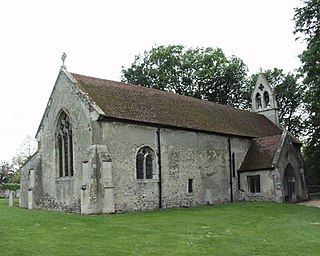
Little Chesterford is a small village and civil parish in Uttlesford, Essex, in the East of England. Close to the Cambridgeshire border, it is built principally along a single sunken lane to the east of a chalk stream tributary of the River Cam or Granta and is located 1 km southeast of Great Chesterford and some 5 km northwest of Saffron Walden. The small hamlet of Springwell is just to the south of the village. Up the hill to the east is Chesterford Park, with a mid-19th-century mansion in a 250-acre estate and now a science park called Chesterford Research Park. The wide and relatively deep valley of the river Cam provides a rolling landscape of chalky boulder clay with extensive and wide views. The surrounding farmland is mostly in intensive arable use and except for areas alongside the river, some of which is liable to flooding, is classified as being of grade 2 quality.

Great Chesterford is a village and civil parish in the Uttlesford district of Essex, England. The village is 13 miles (20 km) north from Bishop's Stortford, 10 miles (16 km) south from Cambridge and about 25 miles (40 km) northwest from the city and Essex county town of Chelmsford.
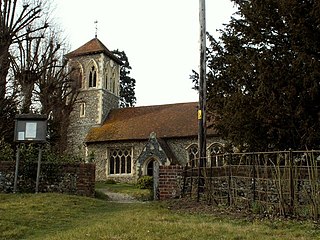
Wicken Bonhunt is a village and a civil parish of north-west Essex, in the non-metropolitan district of Uttlesford, England. It is on the B1038 (Buntingford) road and is midway between the larger villages of Newport and Clavering. The nearest town is Saffron Walden, approximately 5 miles (8 km) away. Stansted Airport is approximately 10 miles (16 km) away. The civil parish has a population of approximately 839.
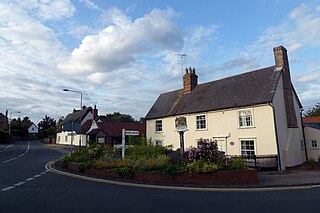
Littlebury is a village and civil parish in the Uttlesford district, north-west Essex, England. The village is approximately a mile and a half from the market town of Saffron Walden, 12 miles (20 km) south from Cambridge, the nearest city, and 23 miles (37 km) north-east from the county town and city of Chelmsford.

Widdington is a village and civil parish near Saffron Walden, in the Uttlesford district, in the county of Essex, England. The population of the parish at the 2011 census was 504. The village is located near the M11 motorway. Widdington has a church dedicated to St Mary the Virgin. Prior's Hall, now a private residence, is a rare survival of a stone-built structure from the late tenth or early eleventh centuries; Prior's Hall barn, from the fourteenth-century, is nearby.

Rickling is a village and former civil parish, now in the parish of Quendon and Rickling, in the Uttlesford district of Essex, England. The village is situated approximately 6 miles (10 km) north from the town of Bishop's Stortford. Saffron Walden, at 5 miles (8 km), and the larger village of Newport, at 2 miles (3 km), lie to the north-east. In 1931 the parish had a population of 378.

The Hundred Parishes is an area of the East of England with no formal recognition or status, albeit that the concept has the blessing of county and district authorities. It encompasses around 450 square miles of northwest Essex, northeast Hertfordshire and southern Cambridgeshire. The area comprises just over 100 administrative parishes, hence its name. It contains over 6,000 listed buildings and many conservation areas, village greens, ancient hedgerows, protected features and a historical pattern of small rural settlements in close proximity to one another.






















